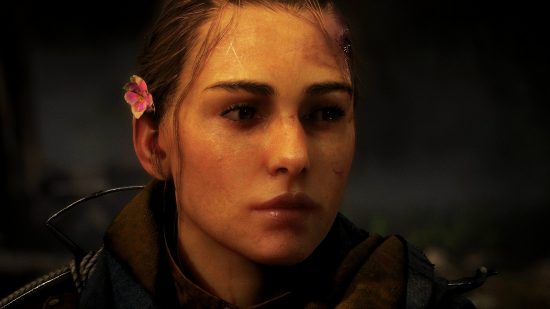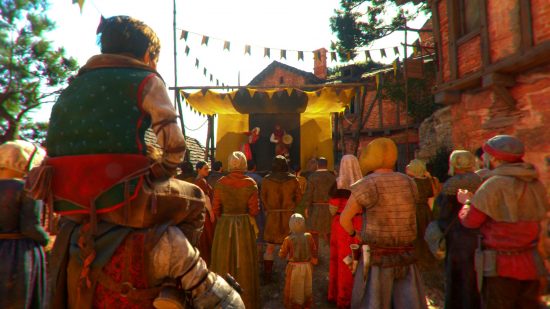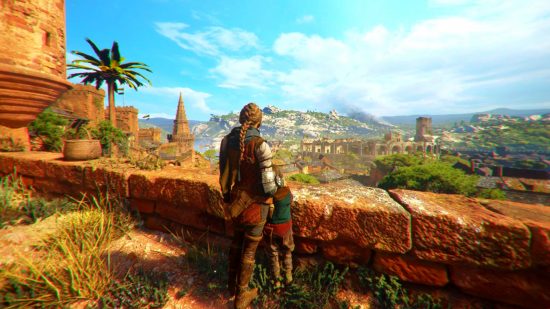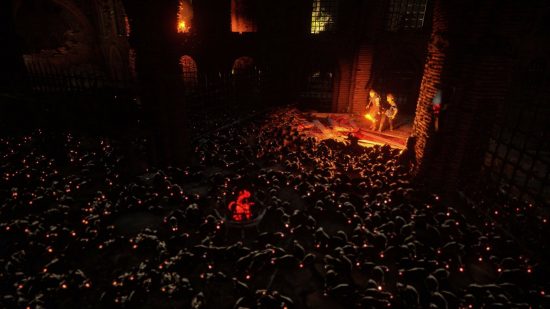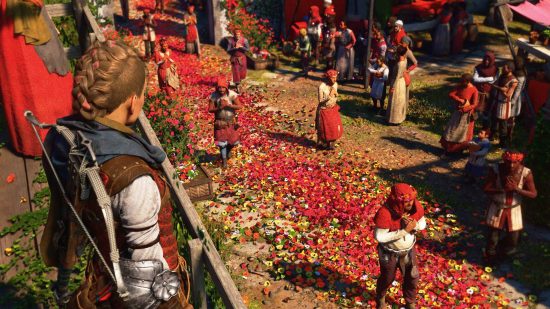Our Verdict
A Plague Tale Requiem is a thrilling continuation of Amicia and Hugo’s story, but the gameplay innovations introduced pale in comparison to the huge strides taken when it comes to the game’s narrative and the world Asobo Studios has created.
Three long years after the climactic battle between Hugo, Amicia, and Grand Inquisitor Vitalis, Asobo Studios is back with another chapter of A Plague Tale’s story. Subtitled Requiem, 2022’s A Plague Tale is just that. With Hugo approaching the final threshold of the Prima Macula and more deadly rats than ever before, the stakes have never really been higher for Amicia and her companions. However, an action-packed adventure-stealth game like A Plague Tale Requiem can’t just rely on high stakes, it needs to play well, too. As someone who became enamoured with the narrative of A Plague Tale Innocence, but feels as though its gameplay was lacking somewhat, I went into this new game apprehensively.
Throughout my playthrough, this unusual sense of apprehension towards A Plague Tale Requiem remained. I desperately wanted it to be a good game – nay, a great game – after Innocence. In my mind, it had to be better. The world Asobo Studios created for the series was full of potential and there were more than a few interesting mechanics in A Plague Tale Innocence; I couldn’t wait to see what the developers had done with them after three more years in the oven.
Unusually, for me, it’s taken the entirety of a playthrough to decide what I really think about A Plague Tale Requiem. There were a lot of moments where I found myself almost annoyed that I had to keep playing, particularly early on. However, much like the hordes of plague-ridden rats that devour everything in sight, this game grows into something quite impressive.
Before I explain why though, let me say that the following review of A Plague Tale Requiem will contain light plot spoilers for the early chapters of the game. I’m not going to really touch upon the ending, but I feel as though it’s important to explain why this game took so long to grip me.
In what feels like an effort to set the scene and re-establish the world of A Plague Tale for returning players, Asobo Studios ultimately does a disservice to the story as a whole by starting so slowly. While you’re not fully re-introduced to the characters from the first game in the series, the opening sequences feel non-consequential and – after playing through the entirety of the game – rather pointless.
They reinforce the notion that both Amicia and Hugo are being hunted – an expected danger after the events of Innocence – and reintroduce basic gameplay mechanics through a series of children’s games played between Amicia, Hugo, and the returning alchemist’s study Lucas. Then, throughout the opening chapters, you gradually gain access to Amicia’s alchemical ammunition – things like Ignifer and Odorous – and her expanded arsenal, which is only expanded upon with the introduction of a crossbow.
It’s far from a bad way to bring players up to speed with the world of A Plague Tale and how the game itself plays, but it’s something of a step backwards when you consider where you leave Amicia and Hugo at the end of the first game. Comically, Amicia does comment that she already knows what things like Ignifer are when they’re re-introduced by Lucas. But, beyond that, the opening chapters do little to deliver on what I was expecting from a sequel to a game like this; I wanted something bigger and better than before, but felt that the start was more an extension of Innocence.
However, this slow start does do an excellent job at setting the stakes and establishing Amicia as a character who can easily lead a series. She’s hardened following the events of Innocence, and stubborn in her insistence that she knows what’s best for Hugo as he reaches the final threshold. Not only this, but she’s confident enough in her own abilities to take on people twice her size and dictate her own path. Where established characters like Hugo and Lucas feel familiar and almost unchanged, Amicia is evolved and ready for the wider world that A Plague Tale Requiem eventually introduces us to.
So, while it might take a little while to get going, once A Plague Tale Requiem reaches this point, it exponentially improves as a game.
The new secondary characters, Arnaud and Sophia, brilliantly add moral complexity to the narrative and interesting new combat mechanics. However, much like Hugo’s developed ability to manipulate rats (thanks to his progression through the Prima Macula’s thresholds throughout Innocence and the early stages of Requiem), they are used more sparsely than I would have liked. These, and many of the other improved combat abilities on offer with Amicia, are something of a novelty. Throughout, I found myself continually restoring back to the basic methods of attack – namely, a standard rock-loaded sling and the fire-extinguishing Exstinguis – to get through combat encounters.
Interestingly, though, you don’t actually get to use everything you have learnt from Innocence in Requiem. Alchemical ammunition like Devorantis (which forces enemies to remove their helmets) and Somnum (which puts enemies to sleep) have been replaced by more violent methods – the crossbow and a knife. This game has a darker tone than the first, when you get stuck into the narrative, and it’s changes like these that inform that and build further on the wonderful development of Amicia’s character.
However, despite these welcome improvements, there are still aspects of A Plague Tale Requiem that remain unchanged from Innocence and do little to build on the bigger picture being painted with the sequel.
For example, the upgrade system for Amicia’s tools remains uninspired and nonconsequential. You can improve the reload speed of the crossbow, reduce the noise made by winding up the sling, and improve the amount of alchemical ammunition you can craft with the abundance of resources you find in the world. They aren’t bad upgrades to have, but I never once found myself noticing a real difference in gameplay after acquiring one.
Sadly, the same goes for A Plague Tale Requiem’s ‘innovative’ three-pronged skill system. In this system, you are rewarded with skills relating to certain gameplay styles depending on how much you adopt them. For example, an aggressive player will find themselves unlocking skills that improve open combat more than they would stealth-based skills. However, I would be lying if I said I felt like they made a difference and informed the way I approached each combat encounter. Some are more balanced for open combat than others and it felt natural to continually switch between the two based on the situation I was faced with.
But, ultimately, this doesn’t matter as much when you consider the fact that this game is largely a narrative experience and not one where the gameplay shines beyond what is expected. If anything, quite a lot of the time, I found the combat encounters and gameplay segments to be repetitive and cumbersome; in a few instances, I felt they ruined the pacing of the narrative a little.
This might not be as clear in the earlier stages of the game, but as you progress through this story, it becomes clear that A Plague Tale Requiem is at its best when it isn’t bogged down by its standard gameplay. At around the halfway mark, the game transforms. It goes from being an average stealth-based adventure game with an intriguing, but overly mysterious narrative, to an action-packed blockbuster with bombastic action sequences and intense emotions. The puddles of rats you navigate cautiously at first, torch in hand, become crashing tidal waves that demolish everything in their path. It goes from steady and safe to drastic and desperate; a situation where running really is your only chance.
In this second half, Asobo Studios clearly raises the bar and delivers a truly heart-wrenching follow on from a game that hooked everyone with its agonising tale of a diseased young boy and his older sister who would do everything she could to help him. However, it just takes so long to get there, creating a divide between the first and the second game in terms of its storytelling.
The message delivered in the final act is a powerful one – and something I’ll have to reflect on – but its poignancy is somewhat marred by the unremarkable gameplay that you have to experience to reach it.
